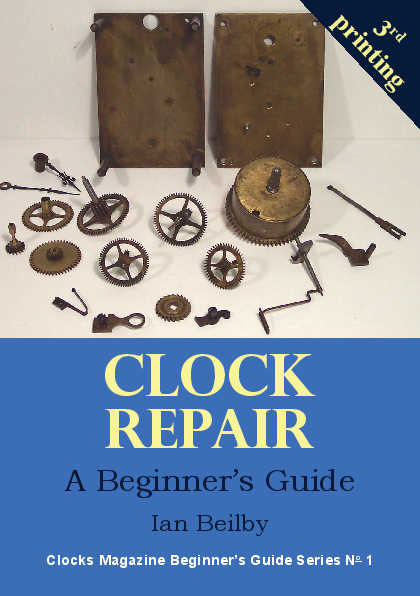
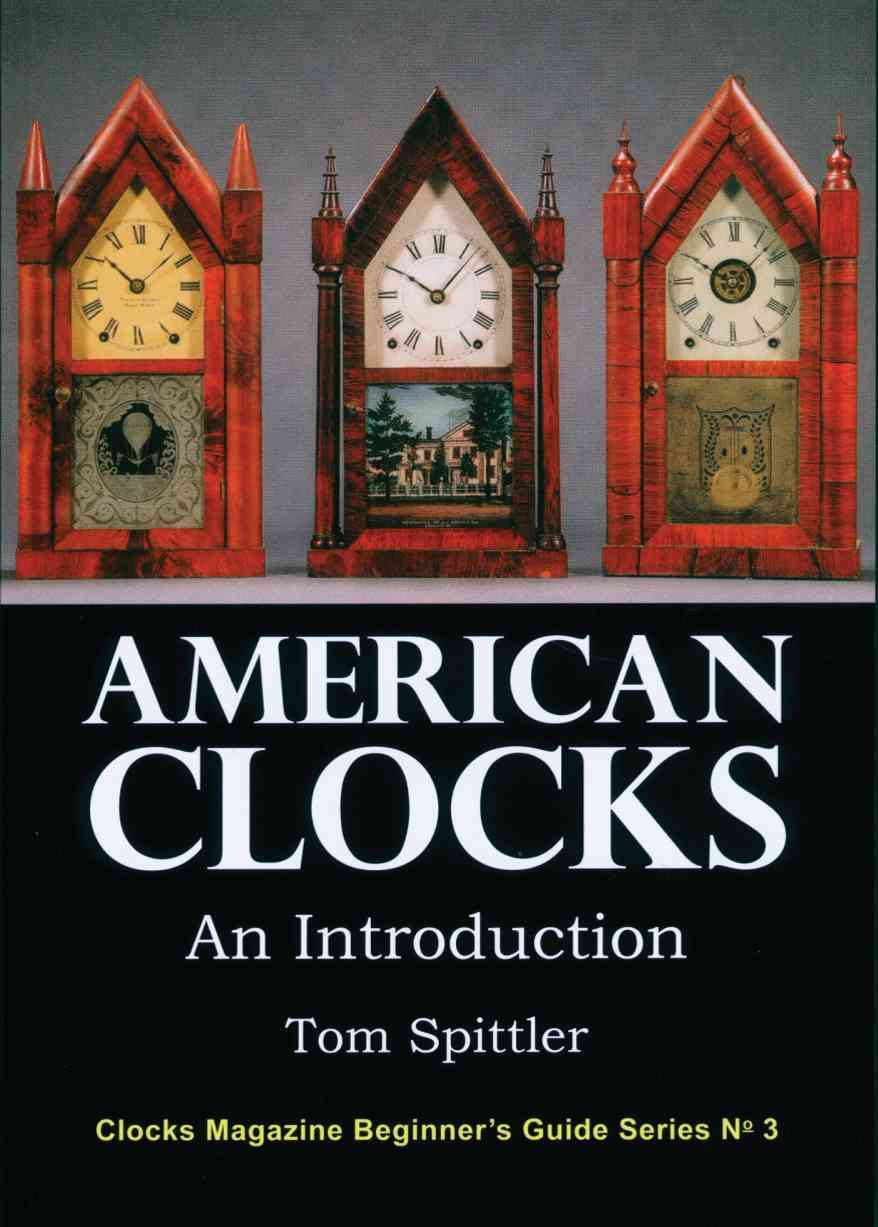

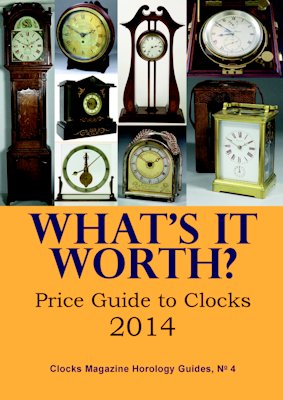
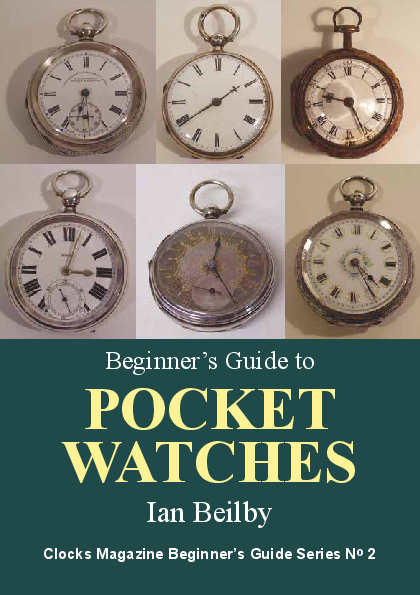
|
| from Clocks Magazine, August 2007 |
French four-glass clocksby Ian Beilby, UKDownload a pdf of this article The majority of French four-glass clocks manufactured during the last quarter of the 19th century could not be simpler in design, and I’m sure that they were offered as a refined alternative to some of the more ornate and highly decorative French mantel clocks of the same period. Sometimes referred to as ‘library clocks’ or ‘crystal regulators’, the name ‘four-glass’ is perhaps more descriptive and accurate. In some respects these clocks are very similar in design to carriage clocks, only they are certainly not portable and were never intended to be so. In order to be a success, the design of the carriage clock had to be both practical and at the same time appeal to the clock-buying public of the day. On both counts the carriage clock was an immediate winner and proved to be a universal favourite. I am sure it was not just the portability of the carriage clock that was responsible for this popularity. By the standards of the day, the revolutionary design, and the all-round visibility of the movement played an equally important part in the clock’s success. Owners do like to see the mechanism of a clock movement, and like to see striking clocks strike the hour. Whereas the carriage clock had to be portable and consequently small and relatively light for ease of transportation, the four-glass clock was not restricted by these constraints. However the French clock manufacturers must have felt that they had to exploit other customer preferences in order to make these ‘larger’ versions as popular as the smaller portable carriage clock. The whole design of the four-glass clock invites inspection on a grand scale, and invariably you find people with no knowledge of a clock movement are drawn to them, peering through the thick bevelled glass of these clocks, hoping to see … I don’t know what! In reality there is very little happening for most of the time; it is only on the hour or the half-hour that the mechanism springs to life, and then only for a relatively short period of time. I am sure the pleasure of viewing a fine quality movement must have mattered to most owners of these well-finished clocks. The cases could easily be fitted with a standard French movement, and from the casemaker’s point of view it was a relatively easy task to make some of the designs slightly different and so offer customers a varied selection to choose from. If the brass cases were dignified and restrained, and the movements of standard manufacture, the same cannot be always said for the dials or pendulums. Here there was ample scope for variety and even complexity in some cases; all highly visible and done to entice the prospective purchaser to buy … in quantity. In fact, apart from slight variations in case design, it is usually the dials and pendulums that offer the most variety and interest with these clocks. Nearly all four-glass clocks have striking movements, striking the hours and half hours on either a bell or gong. Commensurate with a quality French clock, vast quantities of the dials exhibit the Brocot escapement, though by no means all. This is yet another attractive feature found on many quality French clocks. There is no practical need for the escapement to be placed on the front of the dial. In fact by making the escapement so readily accessible, it quite often invites abuse from well meaning but misguided ‘repairers’. It is however a very popular visible attraction on many French clocks, much admired and revered by owners. Figure 1 shows the dial of a four-glass clock displaying a Brocot escapement. The centre of the dial is recessed in order to allow the hands to clear the pallets and escape wheel. The pallets are usually made from half-cylinder semi-precious stones, often termed as being made from ruby or pink sapphire; they are in fact deep-red cornelian stones fixed into place with shellac. The angle of the pallets must be correct for the escapement to function correctly. Substantial collets are fitted to the winding holes of the dial, another sign of quality and finish. The entire dial is well enamelled and delineated and the finely cut hands add to the refinement of the dial. Some manufacturers used this type of clock as a vehicle for unusual or rare escapements and four-glass clocks fitted with duplex escapements have been noted. The movements fitted in most four-glass clocks are usually slightly larger than the normal French clock movements and correspondingly the pendulums tend to be quite large as well. As the pendulums are focally very prominent, the clockmakers took every opportunity to make them visually interesting also. Even the simplest pendulum bob would usually be decorated in some manner. By far the most common type of pendulum encountered on the average four-glass clock was the mercury pendulum as shown in figure 2. Two glass phials are filled with mercury housed vertically in the main body of the pendulum, the idea being that as the liquid mercury expands and contracts with any change in temperature, the change in the mercury compensates the timekeeping of the pendulum accordingly. The majority of mercury pendulums on these clocks were mass-produced, and I do not think the compensating properties of the mercury in relation to the expansion/contraction of the pendulum rod were calculated with any great precision. However they do work to a limited extent, and also look very nice. Perhaps more importantly their use implied that the clock’s timekeeping qualities were comparable with those of a ‘regulator’, a term often applied to a clock fitted with a mercury pendulum. I have seen four-glass clocks fitted with Ellicott pendulums, and if these pendulums are adjusted and working correctly they can also help in compensating for any changes in temperature. The mercury pendulum is not provided with a traditional rating nut and fine adjustment to the timekeeping is made with the suspension-regulating arbor accessible from the front of the dial. Without doubt the majority of four-glass clocks are excellent timekeepers, but this is generally due to the dead-beat escapement and the fine workmanship of the movements rather than any compensating properties of the pendulums. With all these adornments and refinements these clocks were always expensive, and that is still the situation today. 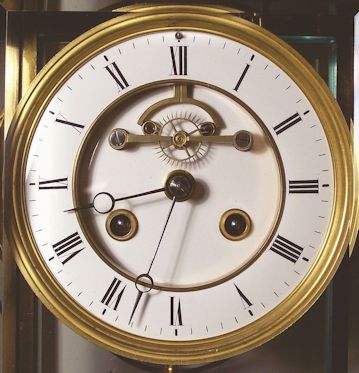
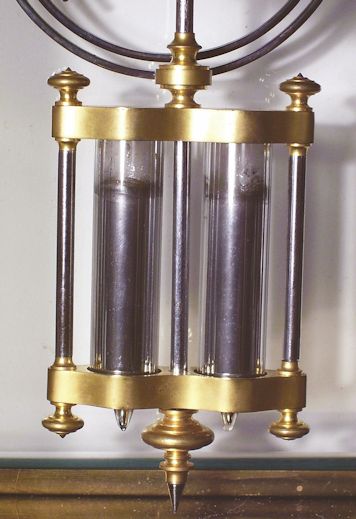

The popularity of the design was such that several American clock manufacturers, and in particular the Ansonia Clock Co, made a large numbers of four-glass clocks, only they were fitted with inferior movements compared to the French clocks of the period. Invariably, not only are the movements of poorer quality, but the cases are inadequately finished and tend to be over decorated, lacking the refinement of their French rival. Sometimes the American ‘mercury’ pendulums contain no mercury at all, and consist of nothing more than steel rods in glass phials … they are probably just as effective! I understand that even now similar four-glass clock are being made in the Far East and are finding their way into this country. The sizes of the French four-glass cases can vary considerably, from 8in tall to 14in or 16in, and anything in between. Certainly the larger clocks are very imposing and without doubt impart a sense of quality and stateliness to their surroundings. Repairs to the movements are generally the standard repairs you would expect to have to perform on most French movements of the period. Being highly visible, the movements should be cleaned regularly, however as they are totally encased they tend not to pick up very much dirt or to tarnish as quickly as movements fitted into other types of case. Figure 3 shows a typical example of a four-glass clock, and you can clearly see the influence of the carriage clock in the case design. The dial and pendulum take centre-stage and the whole appearance is one of quality and elegance. Although the clock shown in figure 4 is very similar to the clock in figure 3 there are one or two slight differences. The case in figure 4 is generally known as a gorge case, due to the channelling cut into the corners of the base and top of the case. This case would be slightly more costly to produce owing to the extra work and finishing involved. The dial has a different style of hands, and the body of the pallets is finished to a different pattern, however in all other respects the dial is the same. The other main difference is in the pendulum. Here, perhaps surprisingly considering this would be a more expensive clock, a rather plain chamfered brass pendulum bob has been used and a more traditional rating nut provided beneath the bob in order to adjust the timekeeping of the movement. A plain case and mercury pendulum has been used for the clock shown in figure 5. On this clock the one-piece dial is not fitted with a visible escapement and is left totally unadorned. Even the dial bezel is of a very simple design. It has to be said that the visible escapement, although a most attractive feature, does tend to distract from the main purpose of the dial … that of telling the time. The plain dial makes reading the time very easy, and in some respects complements the simple lines of the case. 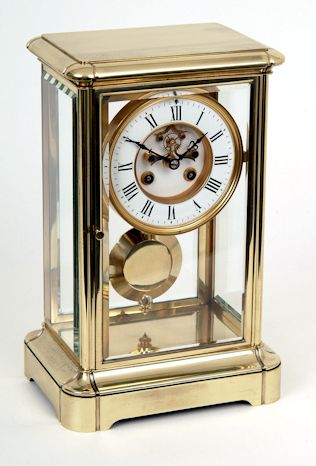

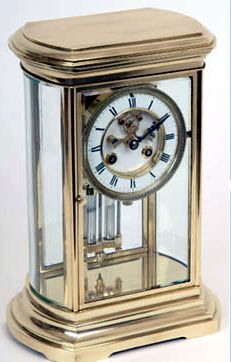
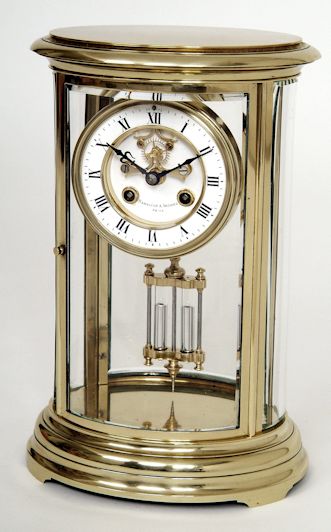
A break from the traditional rectangular shape of most four-glass cases is shown in figure 6. This case has a stepped and curved base and top, and has a slightly more modern feel about it. At this stage the designers were clearly experimenting with the design, wishing to offer something a little different, but also retain the traditional features so popular with this type of clock. This design ultimately led to the introduction of the circular or oval four-glass clock shown in figure 7. The curved glass and construction of the case made these clocks more expensive in relation to the traditional rectangular case, but the new oval shape was a huge success with the public. The slightly less masculine design still retained the traditional features of the standard four-glass clock and the smaller versions of these clocks proved to be exceptionally popular. The majority of four-glass clocks are unsigned, however the dial of this clock is signed with the name of Hamilton & Inches, Paris, a very British sounding firm of Parisian clockmakers! A very similar clock is shown in figure 8. Such was the popularity of this style of case that these clocks were offered in many guises. This clock has a one-piece dial with Arabic numerals and was probably made during the first quarter of the 20th century. If all the previous cases were reserved, and left to speak for themselves, the case shown in figure 9 certainly shouts its presence from the hilltops. 
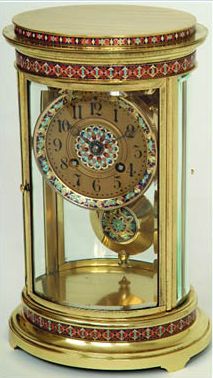
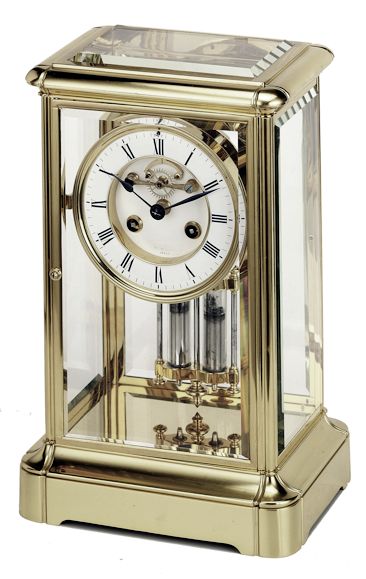
Not only is the champlevé case highly colourful and ornate, but the dial and pendulum have also been treated in a similar manner. To achieve this colourful effect the surface of the metal is chased out and then filled with coloured enamel. Without doubt this well-adorned clock follows the aesthetic trend found on many carriage clocks of the same period. Here sumptuous colourful decoration has been given precedence, and decorative attributes become the clocks main selling points. The final clock shown in figure 10 is not really a four-glass clock at all, but a quite rare five-glass clock retailed by Chas Frodsham & Co, Paris (1858-84). Numbered 19082 the gorge case is exceptionally well made and most unusually posses a fifth glass fitted in the top. This is a very well-constructed clock of substantial proportions. On this clock, not only are the pallets jewelled but the escape wheel front pivot runs in a jewelled bearing as well. Despite all that I said earlier, to me these are more than just hybrid carriage clocks. Although conceived along similar lines, they were clearly intended and marketed for a different type of client. Thankfully the clock-buying public of the 19th century recognised the quality and workmanship being offered to them, and these clocks became almost as popular as their miniature counterparts. Considering the size of some of the cases and the materials employed in their construction, I am amazed that so many of them were exported across the Channel and arrived safely in this country. It would be interesting to know if many panes of glass had to be replaced by the importers or how many clocks arrived in a totally unsaleable condition. In this article I have been able to show only a few of the many different French four-glass clocks available to the average collector, however all the clocks shown are slightly different in one way or another and the total range on offer is vast. Hopefully even this small selection will go some way to indicate the diverse range of four-glass clocks on offer. But perhaps more importantly, I hope I have been able to demonstrate the French clockmaker’s ability to expand and develop an already successful design to its ultimate and undisputed place in the history of clockmaking and design. Acknowledgements I would like to extend my thanks and appreciation to Peter Lightfoot of Summersons Antique Clocks & Barometers, 172 Emscote Rd, Warwick CV34 5QN, for his kind help and permission to use the images shown in figures 3 to 9. Also to William Turk of W F Turk Antique Clocks 355 Kingston Road, Wimbledon Chase, London SW20 8JX, for his kind help and permission to use the image shown in figure 10. Download a pdf of this article |
| © 1977 to 2015 Clocks Magazine & Splat Publishing Ltd |